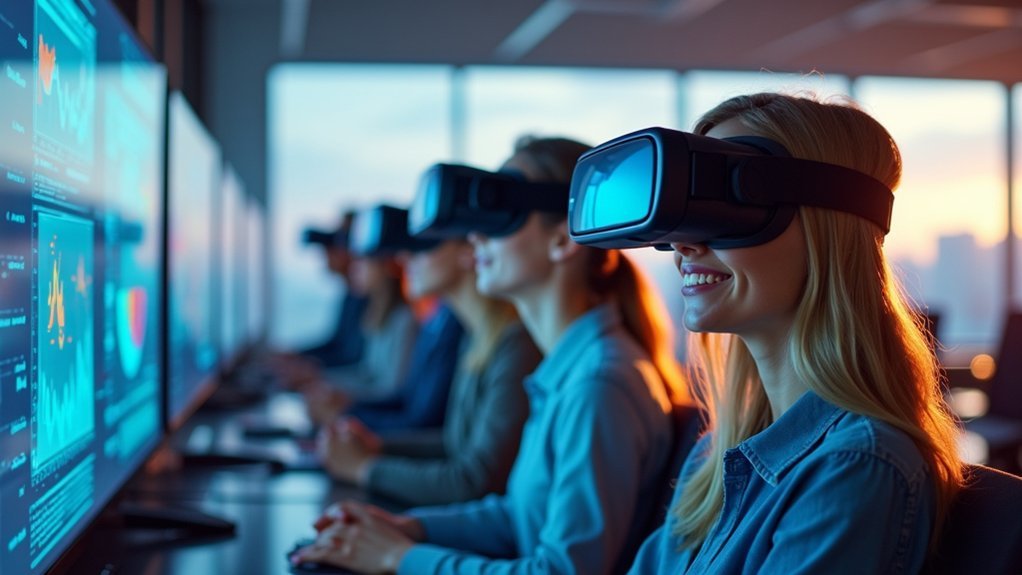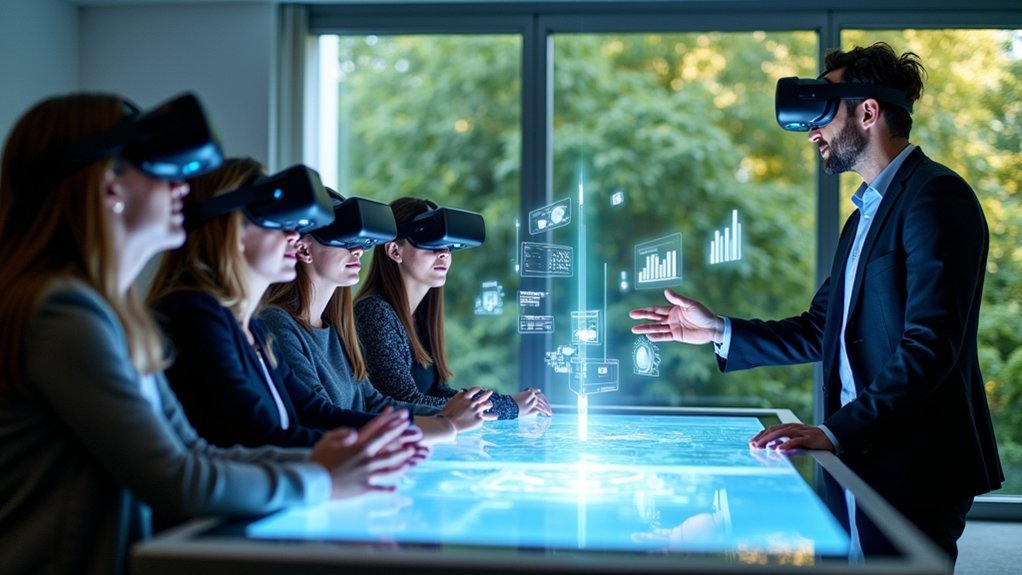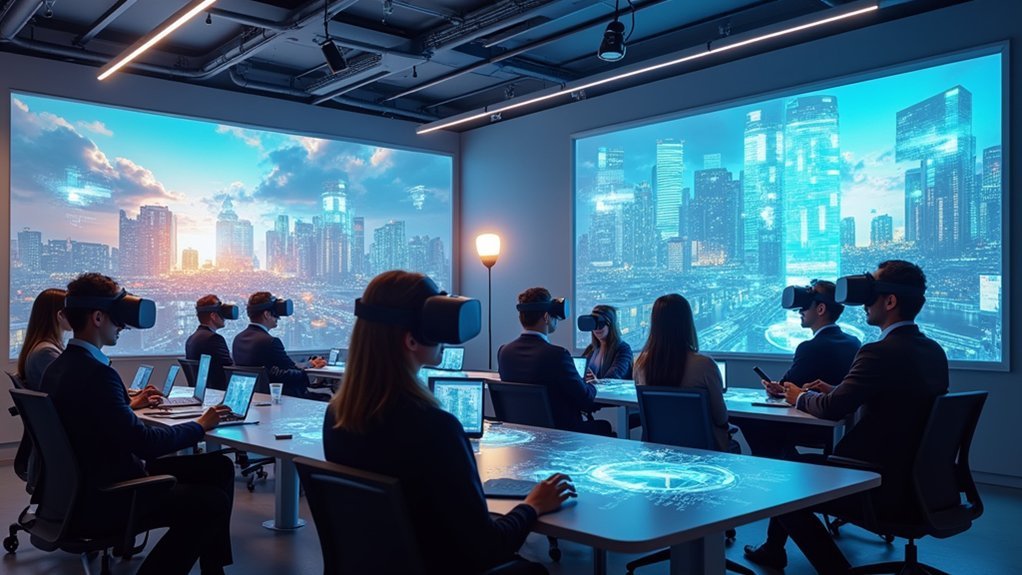You can revolutionize your corporate training by implementing VR, AR, and mixed reality technologies that boost knowledge retention from 30% to an impressive 90%. These immersive platforms reduce training time by up to 75% while cutting assembly errors by 38% and improving emergency response times by 28%. You’ll see enhanced employee engagement through gamification strategies and personalized learning pathways powered by AI analytics. The scalable solutions create standardized experiences across global locations, reducing costs by 50%. Discover the complete transformation strategy that’s reshaping how organizations develop their workforce.
Understanding Immersive Technology in Corporate Learning Environments

Most corporate training programs struggle with low engagement and poor retention rates, but immersive technology is transforming how organizations develop their workforce.
When you implement immersive learning platforms in your employee training programs, you’re leveraging virtual reality (VR), augmented reality (AR), and mixed reality (MR) to create interactive experiences that greatly boost knowledge retention.
These immersive technologies enable your employees to practice skills in realistic scenarios without real-world consequences, building confidence while reducing training time.
Safe practice environments accelerate skill development by eliminating real-world risks while building employee confidence through realistic scenario-based training.
You’ll find that learners retain 90% of what they experience through immersive training, compared to only 30% from traditional methods.
Additionally, analytics integration in these platforms allows you to create personalized learning pathways based on individual performance data, ensuring targeted skill development that meets each employee’s specific needs.
Virtual Reality Simulations for High-Risk Scenarios and Safety Training
VR simulations excel particularly when your employees face high-risk scenarios where real-world practice could result in injury, equipment damage, or catastrophic failure.
Virtual reality (VR) creates safe environments where workers can master critical procedures in healthcare, aviation, and industrial settings without consequences.
You’ll see remarkable improvements in skill development through immersive training.
Studies show VR reduces competency time by 37% while boosting performance in high-stakes situations. Your organization can expect significant safety gains—emergency response times improve by 28% and errors decrease by 45%.
Knowledge retention becomes exceptional with VR safety training, as employees recall 90% of their experiences compared to just 30% from traditional methods.
Companies like Autoliv China and Intel have achieved substantial returns on investment using VR for electrical safety training.
Augmented Reality Applications for Real-Time Job Performance Support

You’ll find that AR technology transforms how you receive work instructions by overlaying digital guidance directly onto your physical workspace, eliminating the need to pause and consult separate manuals or screens.
This real-time support dramatically reduces performance errors since you can follow step-by-step visual prompts while keeping your hands free to complete technical tasks.
Your productivity increases as AR applications seamlessly integrate into existing workflows, providing instant access to troubleshooting resources and assembly instructions exactly when and where you need them.
Real-Time Assembly Instructions
When technicians and assembly workers need guidance on complex tasks, augmented reality (AR) applications deliver real-time assembly instructions that overlay digital information directly onto their physical workspace.
You’ll see step-by-step guidance appear in your field of view, eliminating guesswork and reducing assembly errors by up to 38%. These immersive learning experiences dramatically reduce training time, cutting task completion by 50% compared to traditional methods.
Your training programs become more effective as AR provides instant access to updated instructions and troubleshooting information.
You’ll gain employee confidence knowing expert guidance is always available when tackling new processes. This technology transforms how you learn on the job, supporting continuous skill development while maintaining accuracy and efficiency in manufacturing environments.
Performance Error Reduction
As manufacturing processes become increasingly complex, AR applications serve as your digital safety net, delivering context-specific guidance that prevents costly mistakes before they occur.
These smart overlays dramatically reduce performance errors by positioning critical information exactly where you need it most.
Your workforce benefits from AR’s transformative impact through:
- 38% reduction in assembly errors with real-time guidance systems
- 50% decrease in training time through immersive learning experiences
- Risk-free scenarios that build confidence without real-world consequences
- Enhanced problem-solving skills through contextual visual support
When you implement AR job aids, technicians receive step-by-step instructions while working, eliminating guesswork and confusion.
This technology creates empowered employees who feel supported in their roles, driving improved employee satisfaction and retention rates across your organization.
Hands-Free Technical Guidance
Traditional training methods often force workers to stop mid-task to consult manuals or seek assistance, breaking workflow and creating safety risks.
Hands-free technical guidance through augmented reality (AR) eliminates these interruptions by overlaying digital instructions directly onto real-world environments. You’ll see immediate improvements in employee performance as workers access context-specific information without breaking concentration.
AR applications deliver real-time support that reduces assembly errors by 38% and cuts troubleshooting time by 54%. Your training time decreases by 50%, accelerating skill acquisition for new hires.
With 72% of organizations reporting enhanced confidence and performance, AR transforms how you deliver technical support. Workers receive instant, relevant guidance exactly when needed, maintaining productivity while ensuring safety and accuracy throughout complex procedures.
Mixed Reality Solutions for Collaborative Team-Based Learning

You’ll find that mixed reality transforms how your teams collaborate by creating shared virtual workspaces where remote and on-site employees can interact as if they’re in the same room.
Your cross-functional teams can tackle complex problems together in real-time, manipulating 3D data visualizations and prototypes that everyone sees and modifies simultaneously.
This technology breaks down traditional barriers between departments, enabling your sales, engineering, and marketing teams to collaborate on projects with unprecedented immediacy and clarity.
Real-Time Team Collaboration
When your team members are scattered across different locations yet need to work together on complex projects, Mixed Reality solutions bridge the gap by creating shared virtual environments where everyone can collaborate in real-time.
These immersive learning platforms transform team-based learning by enabling participants to interact with digital content simultaneously, resulting in significant performance improvements.
Your organization can achieve measurable benefits through MR-powered real-time collaboration:
- 28% faster emergency response times during training simulations
- 45% reduction in errors across collaborative exercises
- Enhanced productivity and efficiency through hands-on virtual experiences
- Support for diverse learning styles within the same session
Shared Virtual Workspaces
While physical boardrooms and conference halls remain valuable, shared virtual workspaces represent the evolution of collaborative learning environments where your teams can manipulate 3D models, annotate digital whiteboards, and solve complex problems together—regardless of whether they’re in New York, Tokyo, or working from home.
These immersive training environments deliver remarkable results. Your teams will experience 40% higher collaboration effectiveness through dynamic engagement across geographical boundaries.
Interactive experiences reduce collaborative task completion time by 30%, streamlining workflows considerably. Knowledge retention improves by 25% compared to traditional methods as participants actively engage with shared content.
Mixed reality solutions create psychological safety, enabling experimentation without real-world consequences. Your employees can make mistakes, learn, and iterate freely, strengthening team cohesion while mastering new skills through hands-on practice.
Cross-Functional Problem Solving
Cross-functional teams face their greatest challenges when departments operate in silos, but mixed reality solutions break down these barriers by creating shared problem-solving environments where engineering, marketing, operations, and finance professionals collaborate seamlessly.
Through immersive learning, you’ll engage cross-functional teams in real-time problem-solving scenarios that blend physical and digital elements. This approach delivers measurable results:
- 75% improvement in knowledge retention through immersive experiences
- 50% reduction in training time for skill development
- 28% faster emergency response capabilities
- 45% fewer errors in high-stakes decision-making
Mixed reality enables your teams to interact with shared digital assets, fostering deeper understanding of each role’s responsibilities.
This collaborative approach enhances organizational agility by allowing departments to quickly adapt their skills in dynamic environments while building stronger communication and teamwork capabilities.
Gamification Strategies That Drive Employee Engagement and Participation
As organizations seek innovative ways to enhance employee training effectiveness, gamification emerges as a powerful strategy that transforms traditional learning into engaging, interactive experiences.
You’ll boost employee engagement by 30% when incorporating game elements like points, badges, and leaderboards into your training programs. These immersive learning approaches accelerate skill development, reducing new employee certification time by 28%.
Storytelling within gamified environments creates emotional connections that improve knowledge retention rates up to 75% compared to traditional methods.
You’ll find learners become 3.75 times more emotionally invested in immersive content, driving continuous participation and sustained motivation.
Organizations implementing gamification strategies nearly double employee retention rates, reducing turnover costs while fostering a culture of learning that strengthens workforce stability.
Designing Safe Practice Environments for Skill Development Without Consequences
You’ll find that immersive technology creates risk-free simulation environments where your employees can practice complex scenarios without worrying about real-world consequences.
When you design these safe spaces, you’re enabling mistake-driven learning that actually accelerates skill development—your team can experiment freely and learn from errors without any negative impact.
This approach builds genuine confidence through repeated practice, allowing your workforce to master high-stakes situations before they encounter them in reality.
Risk-Free Simulation Environments
When employees practice critical skills in immersive technology environments, they’re free to explore, experiment, and even fail without facing real-world consequences that could prove costly or dangerous.
Risk-free simulation environments transform how you approach skill development by creating safe spaces where learners can master complex procedures without risking equipment, safety, or reputation.
Virtual simulations deliver exceptional results through:
- Accelerated Learning – Immersive learning reduces training time by up to 50%
- Enhanced Retention – Knowledge retention rates reach 75% compared to traditional methods
- Improved Safety – Organizations see workplace accident reductions of 45%
- Real-Time Correction – Instant feedback enables immediate self-correction
This approach dramatically reduces training costs while maximizing effectiveness, particularly in high-stakes industries like healthcare and aviation.
Mistake-Driven Learning Benefits
Traditional training environments often discourage risk-taking because mistakes carry immediate consequences—but immersive technology flips this dynamic by transforming errors into powerful learning accelerators.
When you practice responding in immersive learning environments, you’re free to make mistakes without career-damaging repercussions. This psychological safety creates space for genuine experimentation and growth. You’ll receive immediate feedback on every decision, allowing real-time correction and skill refinement.
| Traditional Training | Immersive Learning |
|---|---|
| Fear of public failure | Safe space to experiment |
| Limited practice opportunities | Unlimited mistake repetition |
| Delayed feedback cycles | Instant performance insights |
| Extended training time | 4x faster skill mastery |
This mistake-driven approach dramatically reduces your training time while building confidence through repeated practice in realistic scenarios that mirror actual workplace challenges.
Confidence Building Through Practice
Beyond simply learning from mistakes, immersive technology creates controlled environments where you can practice complex skills with complete psychological safety.
This confidence building approach transforms how employees develop expertise through realistic scenarios that mirror actual workplace challenges.
VR training accelerates your skill development by enabling practice four times faster than traditional methods.
You’ll retain 90% of what you experience through these immersive simulations, dramatically improving knowledge retention and application.
The psychological benefits of consequence-free practice include:
- Reduced performance anxiety during formal assessments
- Increased willingness to experiment with new techniques
- Enhanced confidence in skill application by up to 40%
- Improved employee performance through repeated safe practice
Immersive training environments eliminate real-world risks while providing instant feedback, allowing you to refine techniques until mastery is achieved.
Accelerating Employee Onboarding Through Immersive Learning Experiences
Unless you’re willing to accept lengthy onboarding periods that drain resources and delay productivity, immersive learning experiences offer a transformational solution that’s revolutionizing how companies integrate new talent.
You’ll discover that immersive learning can slash employee onboarding time by 75%, delivering a fourfold increase in training speed compared to traditional methods.
Your new hires will benefit from interactive simulations that create safe practice environments where they can develop skills without real-world consequences.
This builds confidence while accelerating competency development. You’ll see knowledge retention rates soar to 75%, dramatically outperforming traditional corporate training’s 30% retention rate.
Through engaging, hands-on experiences, you’ll reduce typical new hire attrition while transforming recruits into productive team members faster than ever before.
Cost-Effective Training Solutions That Eliminate Geographic and Resource Barriers
While geographic boundaries once forced companies to choose between expensive travel budgets and inconsistent training quality, immersive technology now delivers uniform, high-caliber learning experiences to employees anywhere in the world.
You’ll achieve considerable cost savings by eliminating instructor hiring, travel expenses, and facility rentals while accelerating employee readiness through faster skill development.
Immersive learning solutions eliminate geographic barriers through these key advantages:
- One-time content creation deploys across unlimited locations globally
- No-code software solutions empower your training and development teams without technical expertise
- Remote employee engagement maintains consistent quality regardless of distance
- Scalable deployment reduces per-employee training costs considerably
You can now standardize training experiences while cutting costs by up to 50%, ensuring every employee receives identical high-quality instruction regardless of their location.
Enhancing Knowledge Retention Through Emotional Connections and Active Learning
Four times better focus and 90% knowledge retention rates demonstrate how immersive technology transforms corporate training from passive information transfer into emotionally engaging experiences that stick.
When you implement immersive learning environments, your employees don’t just absorb information—they experience it firsthand through simulations and role-playing scenarios.
This emotional connection creates powerful neural pathways that boost retention rates to 75%, compared to traditional methods that achieve only 30% recall.
Active participation through experiential learning builds confidence by 40% while ensuring skills translate directly to real-world applications.
You’ll see the impact in employee engagement metrics too. Companies using immersive training report nearly double the employee retention rates, proving that when learning feels meaningful and interactive, your workforce stays committed to both skill development and organizational growth.
Building Inclusive and Accessible Immersive Training Programs
As immersive technology reshapes corporate training landscapes, you must guarantee these powerful learning environments welcome every employee, regardless of their background, abilities, or circumstances.
Building truly accessible immersive learning experiences requires strategic planning and thoughtful implementation. You’ll need to diversify content by incorporating varied perspectives and backgrounds, ensuring representation across your workforce.
Strategic planning and thoughtful implementation ensure immersive learning experiences welcome diverse perspectives and represent your entire workforce authentically.
Customization features like personalized avatars and inclusive language help employees express their identities authentically.
Essential accessibility features include:
- Captions and audio descriptions for employees with hearing or visual impairments
- Alternative access methods like mobile-friendly options for device-limited users
- Customizable interface settings to accommodate different learning preferences
- Multiple language support for diverse linguistic backgrounds
Leverage analytics to identify engagement barriers and learning patterns. This data-driven approach enables you to continuously refine your programs, ensuring every employee can participate meaningfully in immersive training experiences.
Leveraging Analytics and AI to Measure Training Effectiveness and Performance
When immersive training programs generate massive amounts of learner data, you can transform this information into actionable insights that revolutionize how your organization measures and improves training effectiveness.
Analytics in immersive learning environments enable you to track detailed engagement metrics, providing clear visibility into learner interactions and identifying specific improvement areas.
AI-driven analytics personalize learning pathways by analyzing individual performance data, creating tailored experiences that address each employee’s unique strengths and weaknesses.
You’ll receive real-time feedback that enhances skill development and coaching opportunities.
By integrating these analytics with your Learning Management System, you can evaluate training effectiveness and guarantee alignment with business objectives.
Studies demonstrate that immersive experiences utilizing data-driven insights improve knowledge retention by up to 75% compared to traditional training methods.
Scaling Immersive Learning Solutions Across Your Organization
Successful implementation of immersive learning solutions across your organization begins with establishing clear training objectives that directly support your business goals.
Scaling immersive learning solutions effectively requires strategic planning and the right technological foundation.
Strategic planning and robust technology form the cornerstone of successfully scaling immersive learning across your entire organization.
No-code software platforms enable your L&D teams to create and deploy immersive experiences without technical expertise, accelerating adoption organization-wide.
These solutions help reduce traditional training expenses considerably, with costs projected to decrease from $28.7 billion to $25 billion by 2024.
Consider this four-step scaling approach:
- Launch pilot programs to test effectiveness and gather feedback
- Define measurable training goals aligned with business outcomes
- Leverage data analytics to track engagement and learning metrics
- Implement continuous improvement processes based on performance data
This systematic approach guarantees sustainable growth while maximizing your immersive training investment.
Frequently Asked Questions
What Are the Minimum Hardware Requirements for Implementing Immersive Training Technology?
You’ll need a modern computer with dedicated graphics card, at least 8GB RAM, and compatible VR headset. Don’t forget fast internet connection, updated drivers, and sufficient physical space for movement during sessions.
How Long Does It Typically Take to Develop Custom VR Training Content?
You’ll typically need 3-6 months for custom VR training content development. Simple modules take 8-12 weeks, while complex simulations require 4-6 months. Timeline depends on content complexity, interactivity levels, and your specific training objectives.
Can Immersive Training Technology Integrate With Existing Learning Management Systems?
You can integrate immersive training technology with existing LMS platforms through APIs and SCORM compliance. Most modern VR solutions offer seamless connectivity, allowing you to track progress and maintain centralized learning records.
What Are the Potential Health Risks or Side Effects of Extended VR Use?
You’ll experience eye strain, headaches, and motion sickness with extended VR use. You’re also at risk for neck pain, disorientation, and fatigue. Take regular breaks to minimize these effects.
How Do You Handle Data Privacy and Security in Immersive Learning Platforms?
You’ll need robust encryption protocols, secure user authentication, and compliance with GDPR or CCPA regulations. Don’t store unnecessary personal data, implement regular security audits, and guarantee transparent privacy policies for learners.




Leave a Reply